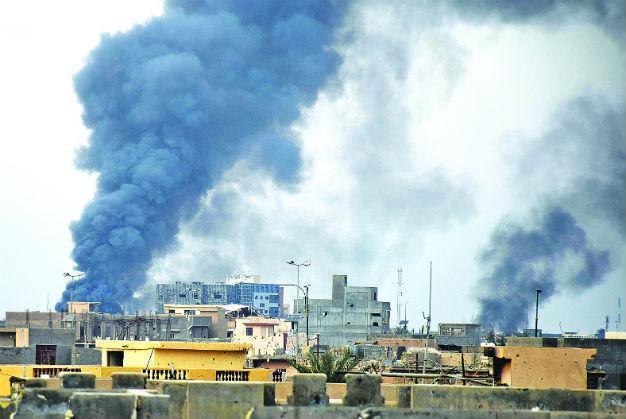Kurdish-Arab alliance pushes ISIL back in north Syria: Spokesman
BEIRUT

AP photo
An alliance of Kurdish and Arab rebels advanced Dec. 24 against the Islamic State of Iraq and the Levant (ISIL) in Syria’s north in a new offensive backed by U.S.-led air strikes, its spokesman said.
Talal Sello, spokesman for the Syrian Democratic Forces, told AFP the SDF offensive was launched late Dec. 23 in the Aleppo province.
“The battle now is aimed at the liberation of areas south of the town of Sarrin... to the Tishreen Dam” on the Euphrates River, Sello said.
Kurdish forces pushed ISIL out of Sarrin in July.
SDF fighters, which predominantly hail from the Kurdish People’s Protection Units (YPG), had advanced to within 12 kilometers from the dam by Dec. 24, according to Sello.
The dam, which has been held by ISIL since 2014, helps generate electricity for large parts of Aleppo province, according to the Syrian Observatory for Human Rights.
ISIL also controls the Euphrates’ western bank, from the northernmost point at Jarablus, which lies on the Syrian-Turkish border, south and further east all the way to Raqqa.
Manbij and al-Bab, ISIL’s strongholds in Aleppo province, lie west of the river as well.
Syrian forces, backed by Russian air strikes, have made gains against ISIL south of those towns.
“Fierce clashes are continuing along the eastern banks of the Euphrates,” observatory head Rami Abdel Rahman said Dec. 24. He confirmed that the SDF had advanced along the banks, but said most of the territory captured consisted of small villages.
Sello said the SDF was receiving backing from the U.S.-led coalition conducting an air war against ISIL in both Syria and Iraq.
The United States and its allies conducted 18 air strikes against ISIL in Iraq and six in Syria on Dec. 23, the coalition leading the operations said in a statement, according to Reuters.
The air strikes in Iraq were concentrated around the northern city of Mosul, where nine strikes destroyed 24 ISIL fighting positions, two vehicles, two machine guns and an excavator, the U.S.-led coalition said in a statement on Dec. 24.
Five strikes near Ramadi, where Iraqi government troops have been waging an offensive to retake the city, destroyed five command and control nodes, “cratered” five roads used by ISIL and denied militants access to terrain, it said.
Iraqi forces battled the last jihadist fighters holed up in the center of Ramadi city Dec. 24, slowed in their advance by stiff resistance, booby traps and fears for trapped civilians.
Fighting raged around the former government headquarters in Ramadi, a key position whose recapture by federal forces would mark another key step toward reclaiming the city they lost to the ISIL in May.
“The Iraqi forces are in Hoz neighborhood... about 500 meters away from the governmental complex,” an army lieutenant-colonel told AFP from Anbar province.
“They are advancing very cautiously” in Hoz, said Sabah Karhout, the head of Anbar provincial council.
He said the huge number of improvised explosive devices planted by ISIL fighters in the city and the possible presence of trapped civilians being used as human shields were the main impediments.
“There’s stiff resistance, there’s been fierce fighting over the last 24 hours in the southern part of Ramadi city,” said the U.S.-led coalition’s spokesman, Col. Steve Warren.
“They’ve established a strong defense using improvised explosive devices as mine fields, booby traps, rigging entire houses to explode,” he said.
